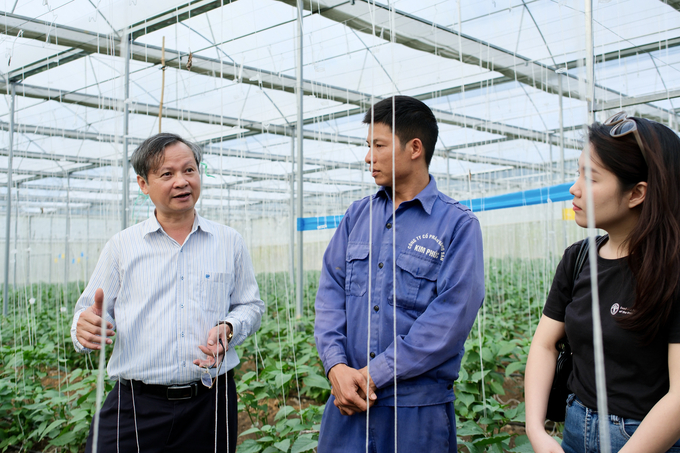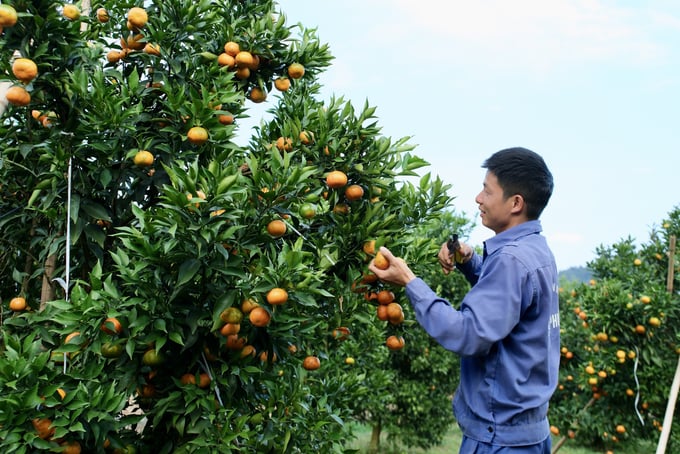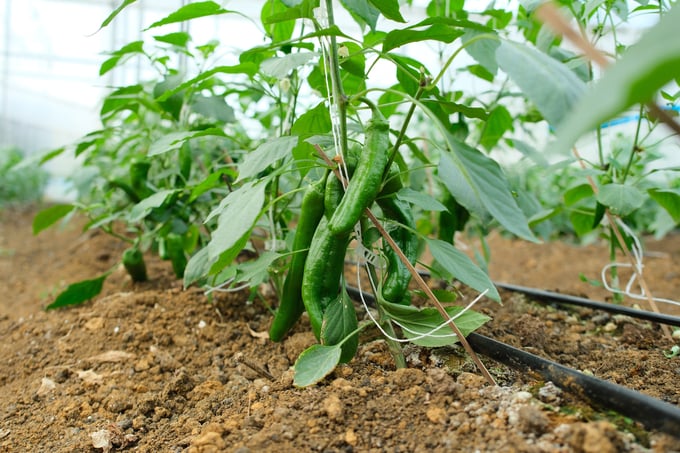November 28, 2025 | 02:55 GMT +7
November 28, 2025 | 02:55 GMT +7
Hotline: 0913.378.918
November 28, 2025 | 02:55 GMT +7
Hotline: 0913.378.918
In Moc Chau district (Son La province), the Fruit and Vegetable Research Institute (FAVRI) has worked closely with the Food and Agriculture Organization of the United Nations (FAO) to support farmers through the “Smart Agriculture for Future Generations” project since 2021. As a result, what were once scattered individual gardens have now transformed into a concentrated vegetable production area under greenhouses, supplying products to Hanoi and surrounding provinces and cities.

Nguyen Quoc Hung, Director of the Fruit and Vegetable Research Institute (left), has confidence in the ability of Son La farmers to access high-tech solutions. Photo: Quynh Chi.
The smart agriculture project is funded by the Korean Government and extends to both Vietnam and Uzbekistan. While greenhouse areas in Uzbekistan typically range from 300 to 500m2, in Vietnam, the Fruit and Vegetable Research Institute has proactively worked with the FAO to secure investment for much larger greenhouses, ranging from 1,500 to 2,000m2.
Discussing the project, Dr. Nguyen Quoc Hung, Director of the FAVRI, explained that the decision to invest in larger-scale greenhouses is not just strategic but also based on the actual capacity and needs of the farmers in Moc Chau.
Dr. Hung noted that international experts initially believed Moc Chau farmers would struggle to access and effectively implement new technology on a large scale. However, after years of collaborating on international projects with the Institute, local farmers have become well-acquainted with high-tech vegetable production techniques. Today, Moc Chau is showing signs of a concentrated vegetable-growing area.
“Moc Chau farmers are ready to innovate. They have the ability to adopt smart agriculture to enhance production efficiency,” Dr. Hung affirmed. He further explained that if the investment is limited to small greenhouses, the economic returns will be low, and the profits will not be attractive enough to encourage widespread participation in the project. He emphasized that what farmers truly need are modern technologies and production techniques, as these are the keys to developing an effective and sustainable concentrated production area.

Son La farmers have sufficient experience and knowledge to transition to high-tech crop production. Photo: Quynh Chi.
At the same time, small-scale farming cannot meet the goal of creating concentrated, commodity-oriented production areas. In this context, a model for safe vegetable production in large greenhouses is essential, requiring investment in integrated equipment and the identification of suitable distribution channels.
After a period of negotiation, international experts and officials gradually recognized the value of this plan and agreed to adjust the investment strategy, opening up new opportunities for Moc Chau farmers. As a result, large-scale production households participating in the project have already achieved significantly higher efficiency.
In previous years, Son La farmers primarily relied on the large land area and traditional farming methods. However, as agricultural land gradually becomes more limited, smart agriculture is becoming an inevitable direction for boosting productivity, optimizing growing spaces, and reducing environmental impact.
Reflecting on the three-year journey of the project’s implementation, Associate Professor Dr. Nguyen Quoc Hung noted that applying high technology in greenhouses has helped manage nutrition and pest control more effectively, resulting in safe vegetable products with stable quality.

Growing sweet palermo peppers in greenhouses shows good prospects, with stable plant growth. Photo: Quynh Chi.
Producing vegetables in greenhouses also offers many significant benefits, thanks to the ability to control environmental factors such as temperature and light. Specifically, when light intensity becomes too high, farmers are trained to use sun-blocking nets to protect their crops. Additionally, pest control equipment is installed in the greenhouses by project staff to prevent pest infestations during the wet rainy season.
Dr. Nguyen Quoc Hung emphasized, “A key factor in the success of the project is the harmonious combination of domestic technologies and technical advancements from international experts. These solutions have been tailored to suit the natural conditions of Moc Chau, helping to optimize production efficiency.”
Translated by Quynh Chi

(VAN) According to Mr. Vo Minh Thanh, Director of the Tay Ninh Department of Agriculture and Environment, Resolution 57 has created a new development pathway for the locality, shifting from traditional toward modern agriculture.
/2025/11/26/4909-2-154329_878.jpg)
(VAN) Pearl grouper farming in HDPE cages not only delivers economic efficiency but also contributes to protecting the environment, creating jobs, and promoting marine-based experiential tourism.

(VAN) The model of making a living under the forest canopy through the agroforestry system in Van Son commune, Bac Ninh province, is expected to generate an annual income of approximately VND 30 million/ha.

(VAN) Many enterprises in Can Tho are harnessing natural energy and reducing greenhouse gas emissions in their production processes, thereby contributing to the promotion of a sustainable green transition.
/2025/11/24/3536-2-112800_176.jpg)
(VAN) Dong Nai now has tens of thousands of hectares of forests certified for sustainable management, and this area will continue to be expanded in the coming period.

(VAN) Vinh Ha hamlet (Dai Xuyen commune, Hanoi) is shifting away from small-scale farming as households adopt bioscurity into their breeder chicken models.

(VAN) Heavy rains make aquatic species more vulnerable to disease. Proactive water management and high-tech systems help farmers prevent outbreaks and protect yields.